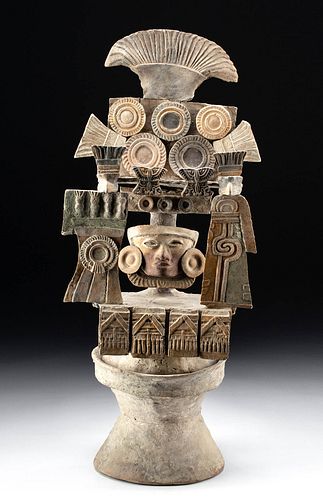Teotihuacan Polychrome Incensario - Theater Type
Lot 135b
About Seller
Artemis Fine Arts
686 S Taylor Ave, Ste 106
Louisville, CO 80027
United States
Selling antiquities, ancient and ethnographic art online since 1993, Artemis Gallery specializes in Classical Antiquities (Egyptian, Greek, Roman, Near Eastern), Asian, Pre-Columbian, African / Tribal / Oceanographic art. Our extensive inventory includes pottery, stone, metal, wood, glass and textil...Read more
Estimate:
$12,000 - $18,000
Absentee vs Live bid
Two ways to bid:
- Leave a max absentee bid and the platform will bid on your behalf up to your maximum bid during the live auction.
- Bid live during the auction and your bids will be submitted real-time to the auctioneer.
Bid Increments
| Price | Bid Increment |
|---|---|
| $0 | $25 |
| $300 | $50 |
| $1,000 | $100 |
| $2,000 | $250 |
| $5,000 | $500 |
| $10,000 | $1,000 |
| $20,000 | $2,500 |
| $50,000 | $5,000 |
| $100,000 | $10,000 |
| $200,000 | $20,000 |
About Auction
By Artemis Fine Arts
Oct 8, 2020
Set Reminder
2020-10-08 10:00:00
2020-10-08 10:00:00
America/New_York
Bidsquare
Bidsquare : Exceptional Antiquities, Asian, Ethnographic
https://www.bidsquare.com/auctions/artemis-gallery/exceptional-antiquities-asian-ethnographic-5796
Museum-worthy examples of Egyptian, Greek, Roman, Etruscan, Near Eastern, Far East / Asian, Pre-Columbian, African / Tribal,Oceanic, Native American, Spanish Colonial, Russian, Fossils, Ancient Jewelry, Fine Art, so much more! Artemis Fine Arts info@artemisgallery.com
Museum-worthy examples of Egyptian, Greek, Roman, Etruscan, Near Eastern, Far East / Asian, Pre-Columbian, African / Tribal,Oceanic, Native American, Spanish Colonial, Russian, Fossils, Ancient Jewelry, Fine Art, so much more! Artemis Fine Arts info@artemisgallery.com
- Lot Description
Pre-Columbian, Mexico or Guatemala, Teotihuacan, ca. 400 CE. A massive incensario made from molded and applied terracotta, with elaborate symbolism and painted pigments on the upper section. The incensario is comprised of two components - an hourglass shaped base that acts as the bowl and the ornate lid. The lid is a conical cover from which a chimney, or clay tube, rises the full height at the back of the piece, and a flat stage-like element, with a figurative mask or face of a deity adorning it. The face has a pensive, serene expression with large ear spools and necklace. The deity is flanked by ornate pillars topped with eagle heads and two butterflies, and above is a rectangular panel with stylized fans and discs, likely intended to resemble a temple or other sacred architectural structure. The surface is painted with orange, white, yellow, red, and blue pigments that add vibrancy to the scene. A fantastic piece, and the smoke from the incense wafting from the chimney must have made the miniature temple appear otherworldly. Size: 12" W x 29" H (30.5 cm x 73.7 cm)
This censer is known as a "theater type" and is among the most emblematic articles of visual culture of Teotihuacan, which then inspired contemporaries and the civilizations that came after them. These were first created in the Tzacualli period (1 to 100 CE), and during the following years, artisans created more and more intricate compositions. Molds were used to make various ornaments that were glued to the primary body and the plates were arranged in superimposed planes as we see in this example. They are known as "theater" because they seem to represent the architecture of a temple, with the mask at the center representing the deity within the temple. Numerous scholars have suggested that censers like this example were instrumental to a cult dedicated to warriors killed in combat. Incense played a major role in religious practice in Mesoamerica, from the Olmec onward. Many tombs are outfitted with incensarios and the items also seem to have been used in ceremonies by the living. The incense was made from copal, tree resin from the torchwood tree. By burning copal, Mesoamerican priests made an offering to the gods - for example, during an Aztec ceremony for the god Huitzilopochtli, the hummingbird-formed god of war, priests hoped that their prayers would be carried upward along with the wafting smoke and scent.
Provenance: private New York, New York, USA collection; ex- Dr. Greg Siskin and Dr. Saul Tuttman 1970s
All items legal to buy/sell under U.S. Statute covering cultural patrimony Code 2600, CHAPTER 14, and are guaranteed to be as described or your money back.
A Certificate of Authenticity will accompany all winning bids.
We ship worldwide and handle all shipping in-house for your convenience.
#159283Expertly repaired from multiple pieces with restoration over the break lines and areas of resurfacing. Some stable fissures and visible break lines. Some nicks to peripheries and high-pointed areas. Great deposits and original pigment remaining!Condition
- Shipping Info
-
All shipping is handled in-house for your convenience. Your invoice from Artemis Gallery will include shipping calculation instructions. If in doubt, please inquire BEFORE bidding for estimated shipping costs for individual items.
-
- Buyer's Premium



 EUR
EUR CAD
CAD AUD
AUD GBP
GBP MXN
MXN HKD
HKD CNY
CNY MYR
MYR SEK
SEK SGD
SGD CHF
CHF THB
THB

















